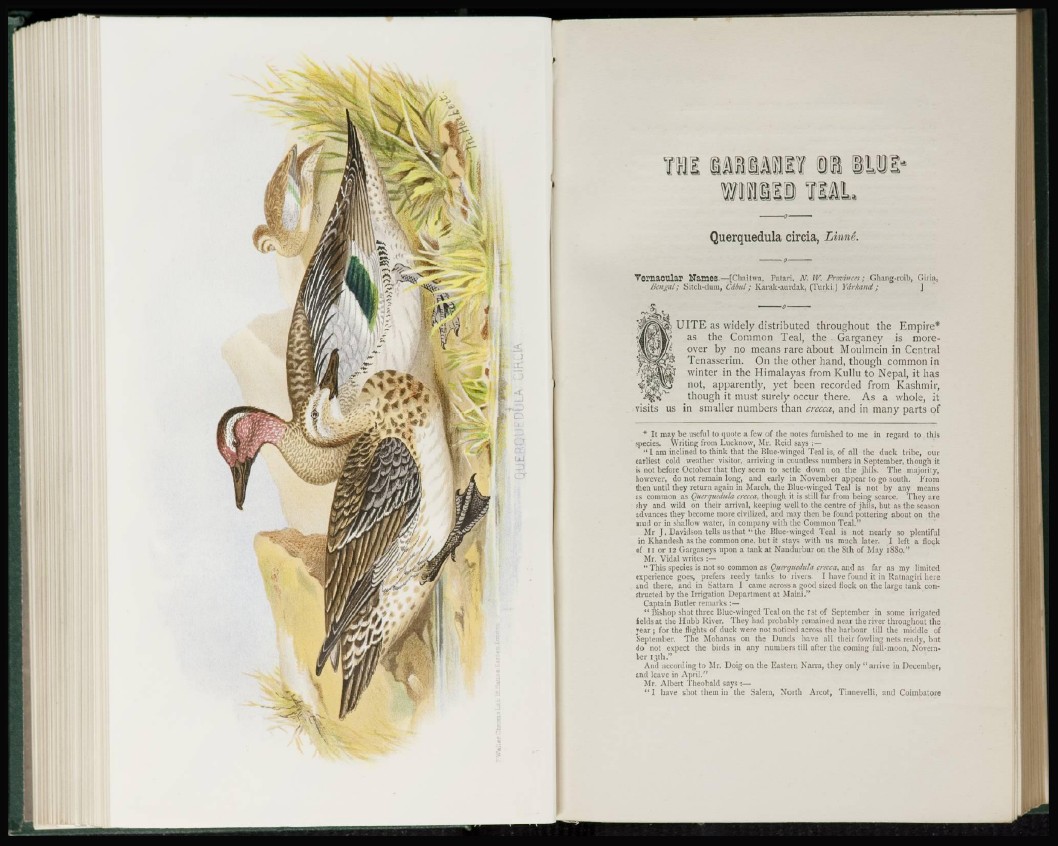
mmt® t SAL
Querquedula circia, Li
Vernacular Names.—[Chaitwa, Patari, N.W. Provinces; Ghang-roib,
Bengal; Sitch-dum, Cdbul; Karak-aurdak, (Turki.) Ydrkand ;
^ UITE as widely distributed throughout the Empire*
as the Common Teal, the Garganey is moreover
by no means rare about Moulmcin in Central
Tenasserim. On the other hand, though common in
winter in the Himalayas from Kullu to Nepal, it has
not, apparently, yet been recorded from Kashmir,
though it must surely occur there. As a whole, it
in smaller numbers than crecca, and in many parts of
* It may be useful to quote a few of the notes furnished to me in regard to this
species. Writing from Lucknow, Mr. Reid says ; —
" I am inclined to think that the Blue-winged Teal is, of all the duck tribe, our
earliest cold weather visitor, arriving in countless numbers in September, though it
is not before October that they seem to settle down on the jhils. The majority,
however, do not remain long, and early in November appear to go south. From
then until they return again in March, the Blue-winged Teal is not by any means
as common as Querquedula crecca, though it is still far from being scarce. They are
shy and wild on their arrival, keeping well to the centre of jhils, but as the season
advances they become more civilized, and may then be found pottering about on the
mud or in shallow water, in company with the Common Teal."
Mr J. Davidson tells us that " the Blue-winged Teal is not nearly so plentiful
in Khandesh as the common one. but it stays with us much later. I left a flock
of 11 or 12 Garganeys upon a tank at Nauduibur on the 8th of May 1880."
Mr. Yidal writes :—
" This species is not so common as Querquedula creeca, and as far as my limited
experience goes, prefers reedy tanks to livers. I have found it in Ratnagiri heie
and there, and in Sattara I came across a good sized flock on the large tank constructed
by the Irrigation Department at Maini."
Captain Butler remarks :—
" Bishop shot three Blue-winged Teal on the 1st of September in some irrigated
fields at the Hubb River. They had probably remained near the river throughout the
year ; for the flights of cluck were not noticed across the harbour till the middle of
September. The Mohanas on the Druids have all their fowling nets ready, but
do not expect the birds in any numbers till after the coming full-moon, November
13th."
And according to Mr. Doig on the Eastern Narra, they only " arrive in December,
and leave in April,"
Mr. Albert Theobald says :—
" I have shot them in the Salem, Noith Arcot, Tinnevelli, and Coimbatore